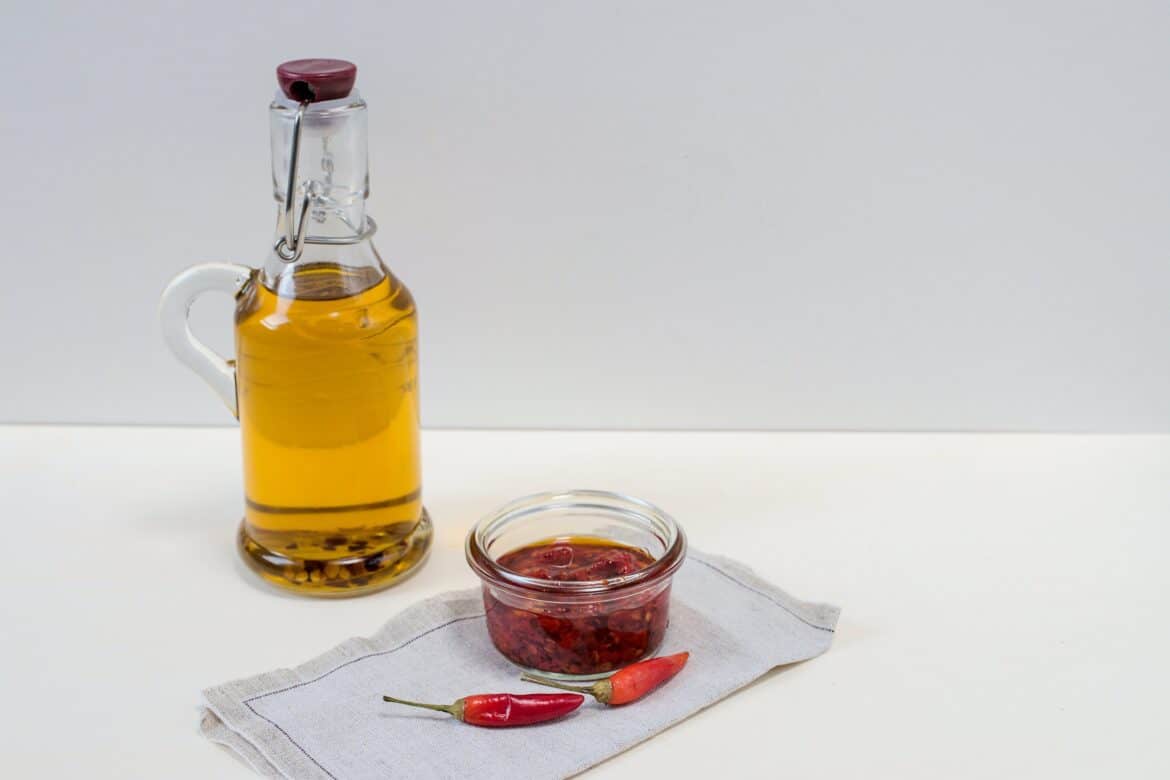Hot chili oil is a staple condiment in many cuisines, known for its vibrant color and fiery kick. This hot chili oil recipe oil adds a burst of flavor to any dish, from stir-fries and noodles to soups and salads. Making your own hot chili oil at home is not only easy but also allows you to customize the heat and flavor to your liking. Hot chili oil is a must-have condiment for anyone who loves bold flavors and a bit of heat.
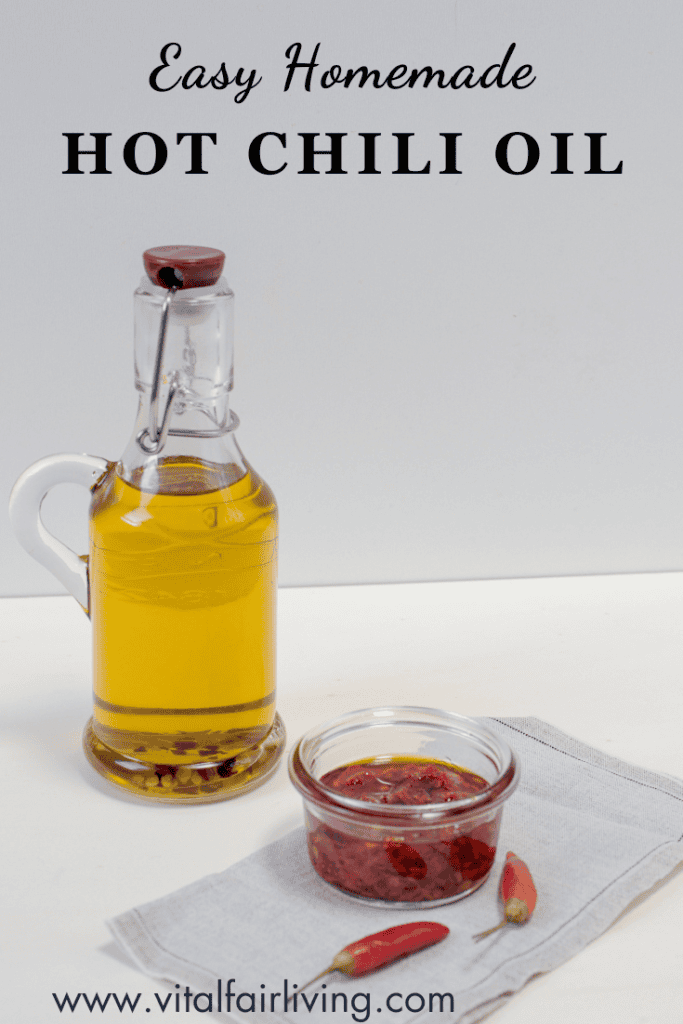
As usual we planted a few hot chili plants in our garden. And in the peak of summer, we will harvest a considerable amount of these hot chilies. I like to make our favorite Fermented Hot Sauce to store in our fridge for the coming winter months.
There is only so much of hot sauce you can store in the fridge, due to the precious fridge real estate. Therefore, I dry some chilies and make chili oil too. Additionally, I use the dry chilies for seasoning in my recipes. I am happy to use our garden produce for longer. Sun dried chilies is what I use for making many of my spice mixes. Moreover, they store longer if kept in air tight containers in a cool and dry place. On the other hand, chili oil also doesn’t need refrigeration.
What is Hot Chili Oil?
Hot chili oil, is also known as chili-infused oil. It is a condiment made by infusing oil with chili peppers and other aromatic ingredients. It’s widely used in Chinese, Thai, and other Asian cuisines to add heat and depth of flavor to a variety of dishes. I always have it on my table because it adds extra flavor to pizzas and pastas. The oil can be as simple as oil and dried chili flakes, or it can include additional ingredients like garlic, ginger, and spices for extra complexity.
Tools you may need to Hot Chili Oil
Disclosure: This post contains affiliate links, meaning, at no additional cost to you, we will earn a small commission if you click through and make a purchase. Learn more
Heavy bottom pot
Ingredients You’ll Need to make Hot Chili Oil
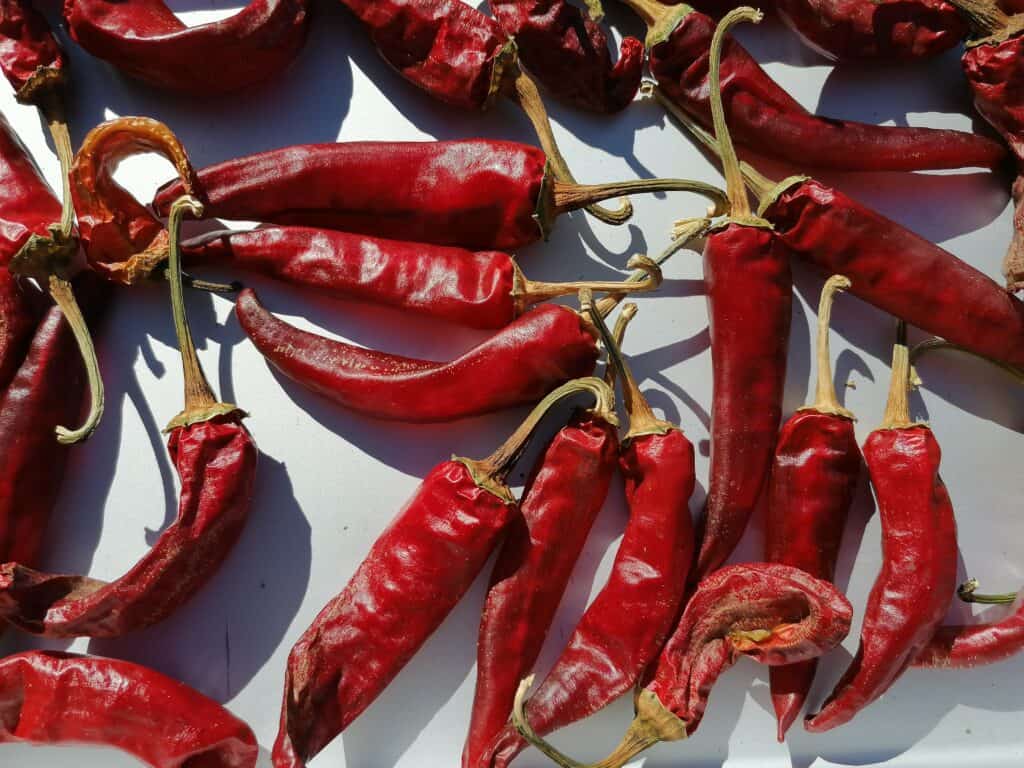
- 1 cup vegetable oil ( I prefer to use Olive Oil )
- 1/4 cup dried chili flakes (adjust according to your heat preference)
- 3 cloves garlic, thinly sliced
- 1 inch piece of ginger, thinly sliced
- 1 tablespoon Sichuan peppercorns (optional for a numbing heat)
- 1 tablespoon sesame seeds (optional for garnish)
- Salt to taste
Method :
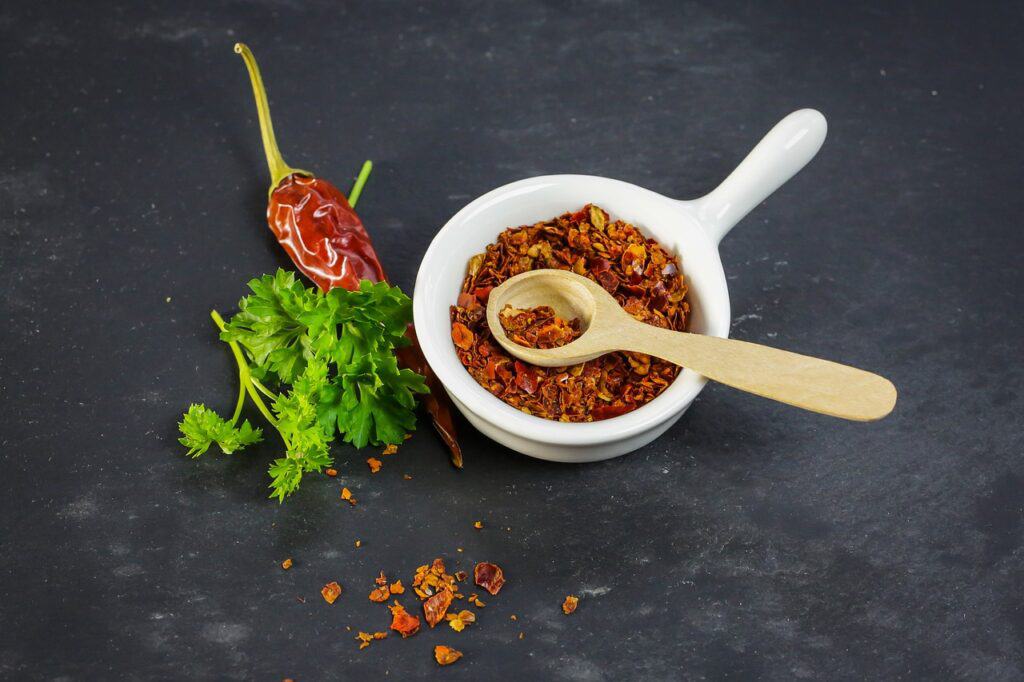
1. Prepare the Ingredients
Measure out the chili flakes, and optional spices if you are using. Slice the garlic and ginger thinly.
2. Heat the Oil
In a small saucepan, add the vegetable oil and heat it over medium-low heat. You want the oil to be hot, but not smoking. The ideal temperature is around 120-150°C (250-300°F) .
3. Infuse the Aromatics
Once the oil is hot, add the garlic and ginger slices. Cook them gently until they turn golden brown, but are not burnt. This will take about 5-7 minutes.
4. Heat
Turn off the heat and let the oil cool slightly for a couple of minutes. Carefully pour the hot oil over the dried chili flakes and Sichuan peppercorns in a heatproof bowl. The oil should sizzle and release the aromatic flavors of the chilies and peppercorns.
5. Cool
Allow the oil to cool completely. As it cools, the flavors will continue to meld together. Once cooled, stir in the sesame seeds and add salt to taste.
6. Store the Chili Oil
Transfer the cooled chili oil, including the solids, to a clean, airtight jar. Store it at room temperature. I usually filter and store it at room temperature and add a couple of dry chilies for decor. If kept at room temperature the flavor will intensify over time. Since you have filtered all the wet ingredients like garlic and ginger, its safer to keep at room temperature.
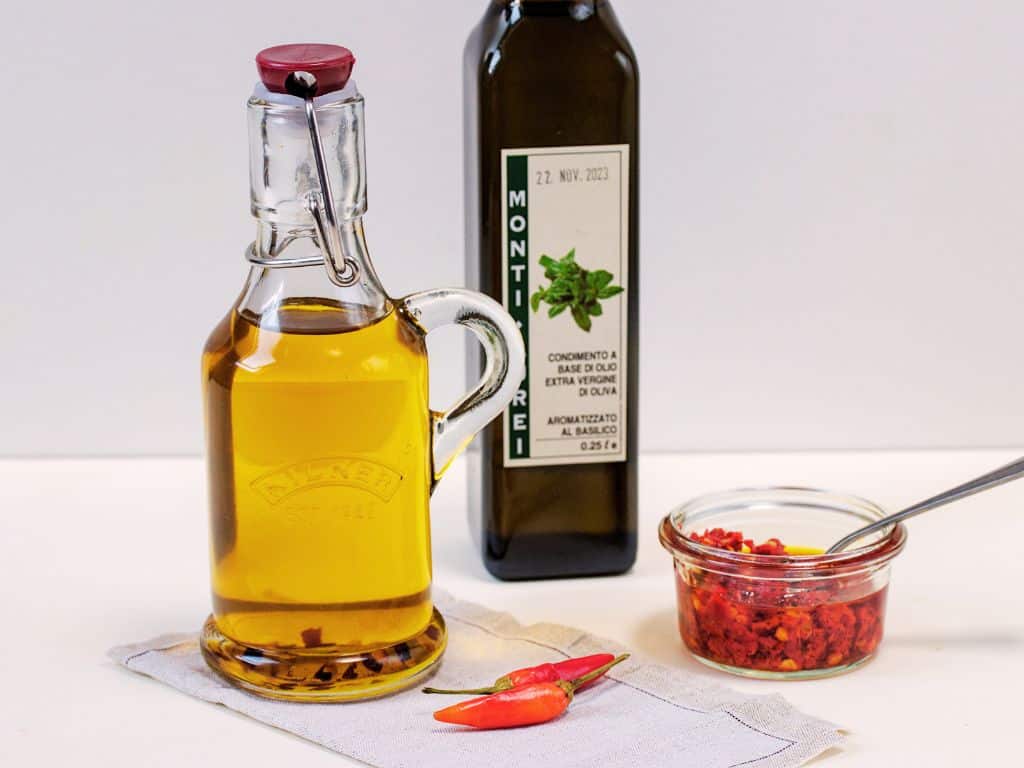
How to Use Hot Chili Oil ?
Hot chili oil is incredibly versatile and can therefore enhance the taste of a variety of dishes:
- Dumplings: Drizzle over steamed or fried dumplings for an extra kick.
- Noodles: Add to your favorite noodle dishes, like Ramen or cold sesame noodles.
- Soups: Stir into soups and broths to elevate the heat and flavor.
- Stir-Fries: Use as a finishing oil for stir-fries and sautéed vegetables.
- Marinades: Mix into marinades.
- Dipping Sauce: Combine with soy sauce, vinegar, and a touch of sugar for a delicious dipping sauce.
- If you are going to filter the flakes, you can use the filtered flakes while making a saute or soup.
Ideas To Customize Your Chili Oil
One of the best things about making hot chili oil at home is the ability to customize it to your taste:
- Heat Level: Adjust the amount and type of chili flakes based on your heat tolerance.
- Aromatics: Experiment with different aromatics like shallots.
- Spices: Try adding other spices like bay leaves, cardamom, cinnamon or cloves for unique flavor profiles.
- Oils: Use different oils like sesame oil for varied flavors.
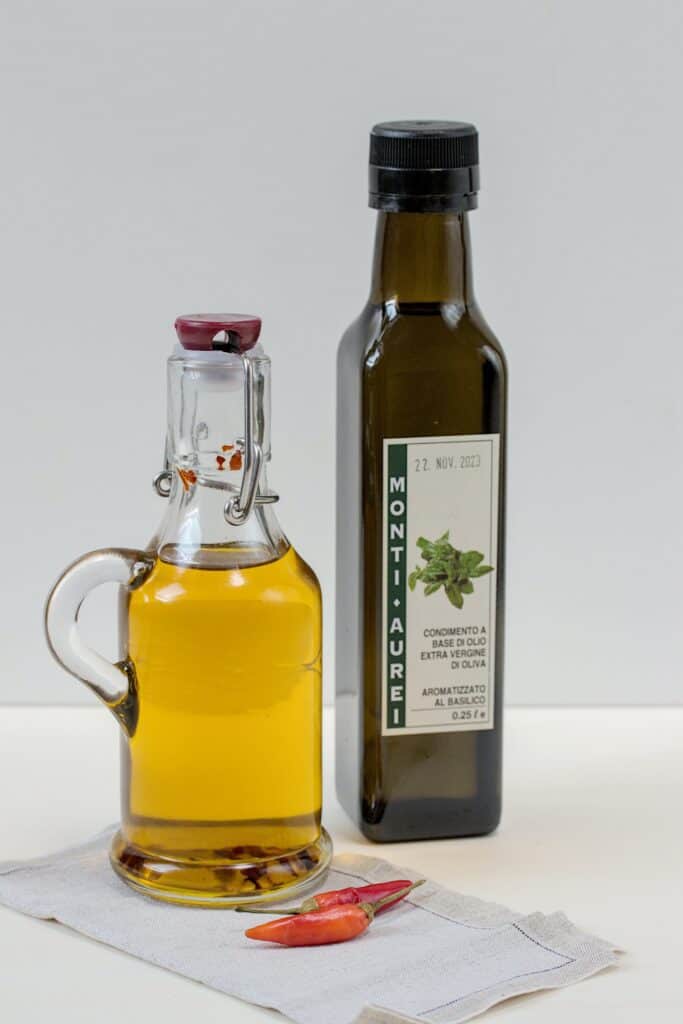
Health Benefits of Hot Chili Oil
While hot chili oil is a flavorful addition to your meals, it also comes with health benefits. Chili peppers contain capsaicin, which is known to boost metabolism, reduce inflammation, and provide pain relief. However, enjoy it in moderation, as it can be quite potent.
Ayurveda, on the other hand limits the use of hot spices for people with a fiery ( or Pitta) constitution. I would be careful to eat too much of chilies as it can trigger acidity. Moderation is the key.
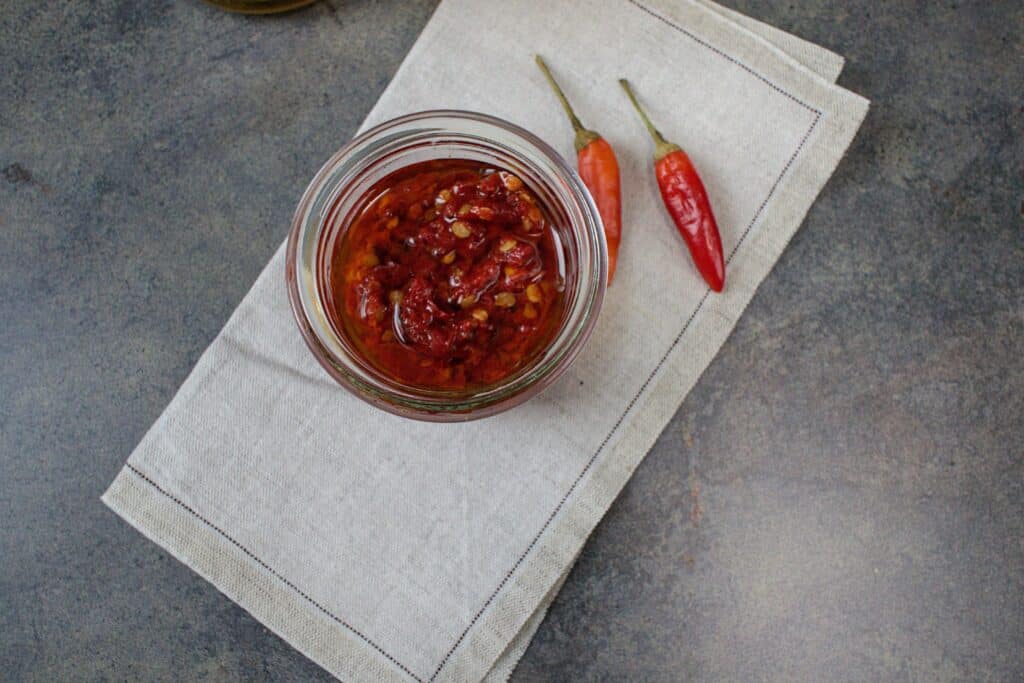
Nutritional Information per Tablespoon (14 grams) of Hot Chili Oil:
- Calories: Approximately 120-130 kcal
- Total Fat: Approximately 14 grams
- Saturated Fat: Approximately 2 grams
- Monounsaturated Fat: Approximately 10 grams
- Polyunsaturated Fat: Approximately 2 grams
Detailed Breakdown:
- Calories:
- The caloric content of hot chili oil comes primarily from the oil itself. Vegetable oils, such as canola, grapeseed, or peanut oil, typically have around 120 calories per tablespoon.
- Fat:
- Total Fat: Most of the calories in hot chili oil come from fat, as oil is 100% fat.
- Saturated Fat: The amount of saturated fat will vary slightly depending on the type of oil used, but it generally makes up a small portion of the total fat content.
- Monounsaturated and Polyunsaturated Fats: These healthier fats make up the majority of the fat content in oils like canola or grapeseed oil.
Factors Affecting Nutritional Content:
- Type of Oil: Different oils have slightly different nutritional profiles. For instance, olive oil has more monounsaturated fats, while sunflower oil has more polyunsaturated fats.
- Additives: The addition of ingredients like sesame seeds or peanuts can slightly increase the calorie and fat content.
- Quantity of Chili Flakes: The chili flakes themselves add negligible calories and fat.
Tips for Healthier Hot Chili Oil:
- Choose Healthy Oils: Use oils high in monounsaturated and polyunsaturated fats, such as olive oil, canola oil, or grapeseed oil.
- Moderation: While hot chili oil can add a lot of flavor with just a small amount, be mindful of the serving size due to its high calorie and fat content.
Your feedback is valuable
If you try this recipe and love it, I would love if you come back and gave it 5 stars! Thank you so much for visiting Vial Fair Living – we’re so happy you’re here! I would love it if you can share this recipe using the social media buttons you see next to the post.
Choose Healthy Oils: Use oils high in monounsaturated and polyunsaturated fats, such as olive oil, canola oil, or grapeseed oil.
Moderation: While hot chili oil can add a lot of flavor with just a small amount, be mindful of the serving size due to its high calorie and fat content.
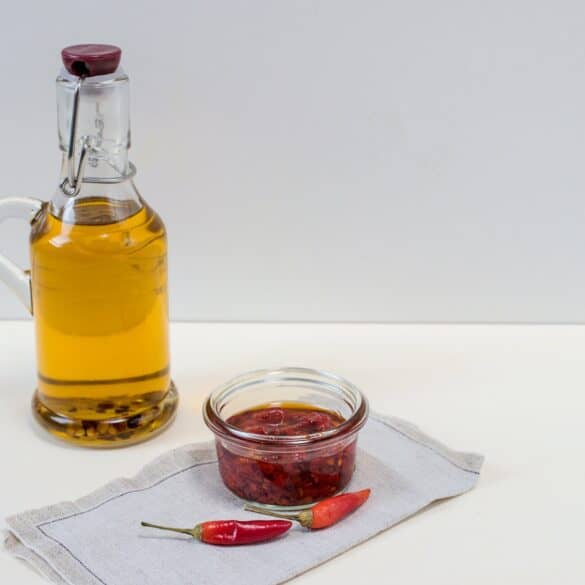
Ingredients
Instructions
Notes

